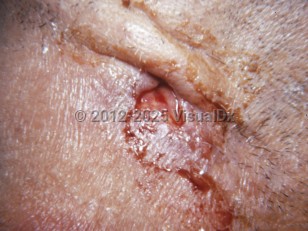Cervical lymphadenitis in Adult
Alerts and Notices
Important News & Links
Synopsis

Cervical lymphadenitis refers to inflammation or enlargement of the cervical lymph nodes. Lymph node enlargement is secondary to a reactive process or infection in the region drained by the cervical lymph nodes or due to cellular duplication within the lymph node. Physical examination may reveal fever, tender cervical lymphadenopathy, erythema overlying the involved lymph node, neck pain, neck stiffness, or torticollis.
Common risk factors include symptoms of an upper respiratory infection such as rhinorrhea, coryza, conjunctivitis, fever, or earache, recent dental work, poor dentition / oral hygiene, or contact with animals such as kittens or livestock.
Careful history and physical exam of the neck for unilateral or bilateral enlargement and other nodes for enlargement is an important first step in establishing an underlying cause.
Common risk factors include symptoms of an upper respiratory infection such as rhinorrhea, coryza, conjunctivitis, fever, or earache, recent dental work, poor dentition / oral hygiene, or contact with animals such as kittens or livestock.
Careful history and physical exam of the neck for unilateral or bilateral enlargement and other nodes for enlargement is an important first step in establishing an underlying cause.
Codes
ICD10CM:
I88.9 – Nonspecific lymphadenitis, unspecified
SNOMEDCT:
3502005 – Cervical lymphadenitis
I88.9 – Nonspecific lymphadenitis, unspecified
SNOMEDCT:
3502005 – Cervical lymphadenitis
Differential Diagnosis & Pitfalls

To perform a comparison, select diagnoses from the classic differential
Subscription Required
Best Tests
Subscription Required
Drug Reaction Data
Subscription Required
References
Subscription Required
Last Updated:09/16/2015
Cervical lymphadenitis in Adult

